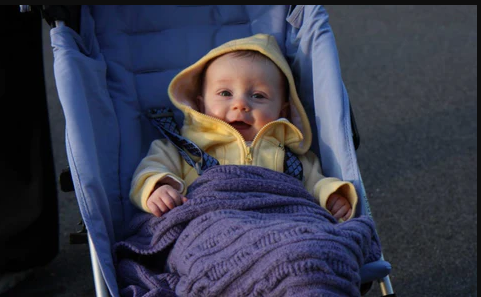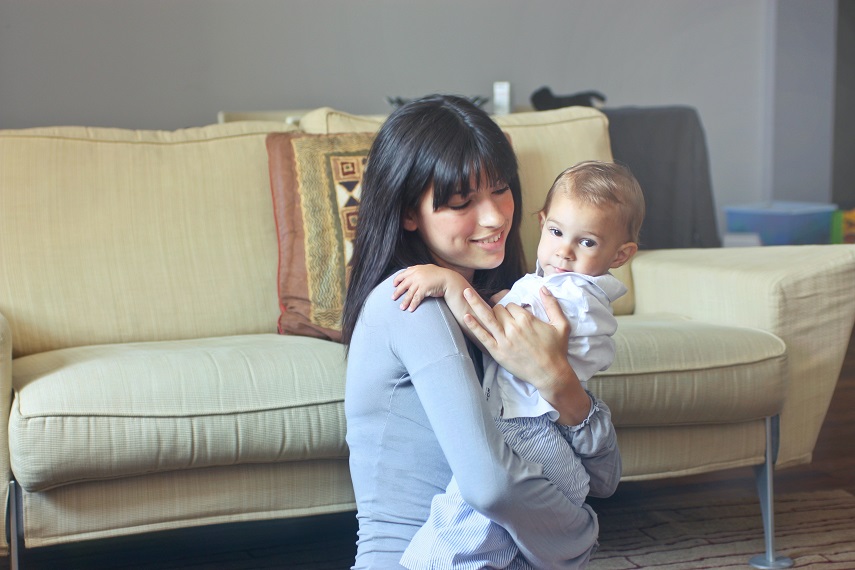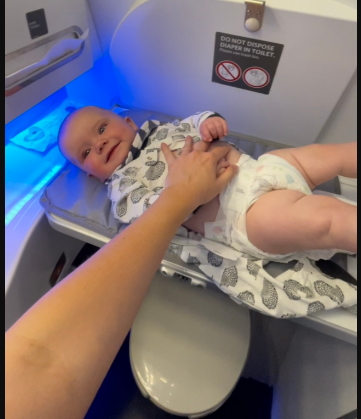When your baby can ride comfortably in a front-facing stroller is determined by their age and physical development. It is critical to consider safety and durability when selecting such a stroller.
Pediatricians often recommend that babies be at least 9 months old and weigh at least 20 pounds before using front-facing strollers. There are, however, exceptions.
For example, if your child is 12 months or older and can support their head, these strollers are generally safe to use. When used on younger or lighter newborns, they may cause discomfort or neck strain.
If your child is under 9 months old, weighs 15 pounds, and can hold their head up, they may be able to ride in a front-facing stroller.
Similarly, if they are older than 15 months but weigh less than 20 pounds, it may still be safe, provided there are no difficulties with the seatback height of the pram.
WHY ARE STROLLERS MADE TO GO FORWARD?
Strollers are carefully built with babies’ safety and comfort in mind.
Keeping the Natural Head and Neck Position
The fundamental reason for facing forward in strollers is to keep a baby’s head and neck in a naturally aligned position.
The posture of a baby’s head is critical to their respiration. A baby’s head being moved too much to one side may impede their airway, putting them at risk of asphyxia.
While you choose to have your baby face you while strolling, their nose often leans towards your chest, potentially making it more difficult for them to breathe comfortably, especially while walking or running outside in cold weather since your body heat may be lost.
Babies’ Opportunity to Observe and Discover the World
From the moment babies are born, their developing brains eagerly absorb everything they encounter sights, sounds, and sensations. Their quest to understand their environment is an ongoing journey that spans their entire lives.
Babies possess an innate curiosity about the world, and front-facing strollers offer them an enhanced perspective of their surroundings.
When parents use a rear-facing stroller, they remain unaware of their child’s viewpoint as the baby’s gaze is directed away from them, preventing them from sharing the child’s observations and experiences.
ARE FRONT-FACING STROLLERS BEST FOR LARGE TODDLERS?
Front-facing strollers are unquestionably the best option for tall kids, particularly those above the age of three. As your child grows taller and heavier, choosing a stroller that can support their size becomes critical.
Explore our extensive Revive Baby blog for additional information on the best strollers for tall toddlers.
Several criteria must be considered while selecting the best stroller for your tall kid, including their height and weight. When your child outgrows a rear-facing pram, switching to a front-facing pram is the best option.
WHAT ARE THE PROS AND CONS OF FRONT-FACING STROLLERS?
Pros of using a face-forward stroller
There are numerous advantages to using a face-forward stroller over a parent-facing stroller. Among these advantages are:
Better Eyesight for Your Youngster:
When your child faces forward in the pram, they have a wider field of vision, allowing them to examine their environment more efficiently than when they face backward.
This increased visual engagement can help children develop better social skills and a more efficient memory since they actively learn from their surroundings rather than relying only on recollection when experiencing new events.
More Control Over Their Environment:
Because they have more control over their environment, they are more likely to feel comfortable and secure, which leads to higher enjoyment of whatever activity they are performing.
They Can See You Better:
Another advantage of front-facing strollers is that children can see you better and thus feel more connected. This makes it easier for kids to learn how to communicate with others, which will help them develop better social skills later in life.
Greater Balance:
Having a greater balance allows them to maneuver themselves more efficiently, which boosts their confidence and self-esteem!
Safety:
Safety is the primary reason why parents should move their children from rear-facing to front-facing.
When your child is in the back of the pram, there is nothing between them and an accident that may occur in front of them (such as a car hitting them). However, if they are seated in front of you, they will be safe.
Easy to communicate with you:
The capacity to communicate with you will allow them to ask you questions about what they see around them and tell you what they want to do when on an expedition with you.
This will allow parents to spend more time with their children by having meaningful conversations with them rather than merely reacting with one-word answers.
They can enjoy the outdoors:
When you stroll around with your baby facing forward, they can take in more of what is going on around them than when they are facing away from you.
This is because they can see everything going on around them, not just minor details. It will also help you to spend more time together because you will have something in common rather than just having each other as a company.
They Can Share Experiences with Older Siblings:
As soon as your baby reaches the milestone of sitting up independently, they can partake in outings that involve walking, such as trips to the grocery store or shopping malls.
Additionally, they can engage in the same activities as their older siblings, like enjoying leisurely walks in the park or playing together, fostering a stronger bond among siblings.
Cons of Using Front-Facing Strollers?
Front-facing strollers provide parents with proximity, security, and a glimpse of their surroundings, but they also have several drawbacks:
Limited Field of Vision:
A baby in a front-facing pram sees only what is directly in front of them, ignoring everything beyond their line of sight. This limitation may limit their exposure to new experiences and their capacity to completely investigate their surroundings, as opposed to facing backward.
Increased Germ Exposure:
Babies may be exposed to more germs in front-facing strollers due to the surface on which they sit as well as other persons touching or using the stroller. Furthermore, debris from the ground may blow into their faces, posing a danger.
A COMPARISON OF FACE-FORWARD VS. PARENT-FACING STROLLERS
The fundamental distinction between parent-facing and face-forward strollers is the orientation of the kid within the stroller:
Strollers that face the parent:
The youngster sits facing the parent in a parent-facing pram. This configuration allows parents to retain direct visual contact with their children and interact with them while on the go. It’s an excellent choice for families looking for some bonding time while on vacation.
Face-Forward Strollers:
Face-forward strollers, on the other hand, place the child in front of the parent, facing away from them. While this may cause some concern at first, it has various advantages.
It lets the infant independently explore and examine their surroundings, eliminating the need for continual parental holding. Furthermore, it promotes more natural interactions with others.
Furthermore, because there is no requirement for the rear portion that would enable a backward-facing arrangement, as found in classic parent-facing strollers, face-forward strollers often have more storage room.
The decision between these two types of strollers comes down to your family’s tastes, your child’s developmental stage, and your individual demands when out and about.
Types Of Front-Facing Stroller
Today’s market offers a vast range of front-facing strollers to meet a variety of demands and preferences. Here are some of the most common:
Car Seat Adapter for Infants:
These strollers are designed to securely attach baby car seats, providing babies with a smooth transfer from the car to the stroller. They give parents with extremely young children with ease and flexibility.
Convertible Baby Stroller:
Convertible strollers are adaptable and versatile, with adjustable seating configurations to meet different ages and stages of your child’s development. They can be transformed from a single to a double pram, and they have reversible seating for both forward and rear-facing babies.
Jogging Stroller:
Jogging strollers are designed for active parents and include durable wheels and suspension systems to ensure a smooth ride whether running or walking on diverse terrains. They enable parents to maintain an active lifestyle while having their youngsters positioned comfortably in front.
Double Baby Stroller:
Ideal for families with many small children, double strollers are available in tandem (one seat behind the other) or side-by-side (seats next to each other) arrangements. For parents with two children, they provide convenience and comfort.
Travel Systems:
Travel systems combine a stroller with an infant car seat to provide a complete option for on-the-go parents. These systems allow for smooth transitions between driving and strolling, making them especially handy for busy families.





